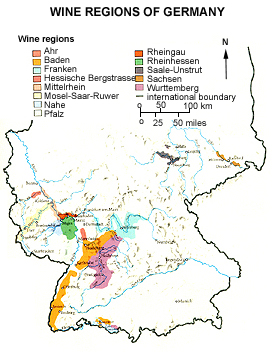| |


Since the 1960s the German vineyards have expanded by more than 50%. As the best sites had already been planted, often for centuries, most of the new vineyards were inevitably created in rather ordinary sites, providing the cheap wines required by German chain-stores, and their equivalents on the export market. Germany sells abroad some 27% of its wine production, or 30 million cases, each year. Its most important customer is the UK, followed by the Netherlands, Japan and the USA. At the same time it imports the equivalent of 97 million cases of wine annually, mainly from Italy, France and Spain. Germany is the largest importer of wine in the EC.
Many of the German vineyards have been reshaped since the 1960s to allow mechanization: this reduces running costs by up to a half. Some of the results of this Flurbereinigung (reshaping) are unattractive to look at (notably so in the Kaiserstuhl district of Baden), and in some cases growers have complained about a deterioration in the local climate. But the benefits outweigh the disadvantages.
A parallel trend has been the rise of new vine varieties, competing with and to some extent supplanting the classic Riesling and Silvaner. The new vines are the result of crossing existing varieties: the aim of the plant scientists was to enhance yield, produce higher must weights, reduce vine diseases and provide characterful wine.
The first such crossing was Muller-Thurgau (Riesling x Silvaner), which can produce a serious white wine from a small yield when planted in a good site.
Scheurebe (Silvaner x Riesling) is, judged by quality of wine alone, the best of the crossings. Its most successful wines are produced in the Pfalz, where the strong bouquet and high acidity can result in characterful wine for long-term keeping.
Kerner (Trollinger x Riesling) is popular for a robust character, regular and high yields, and must weights that frequently allow the wine to be sold as Spatlese or Auslese. Although reliable, it lacks the charm or finesse of its Riesling parent.
|
|
|
|




